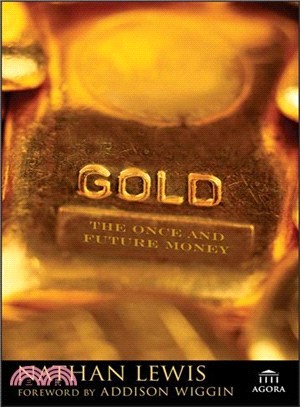| FindBook |
有 1 項符合
GOLD: THE ONCE AND FUTURE MONEY的圖書 |
 |
GOLD: THE ONCE AND FUTURE MONEY 作者:NATHAN LEWIS 出版社:JOHN WILEY & SONS,LTD 出版日期:2007-04-20 規格: / 精裝 / 447頁 |
| 圖書館借閱 |
| 國家圖書館 | 全國圖書書目資訊網 | 國立公共資訊圖書館 | 電子書服務平台 | MetaCat 跨館整合查詢 |
| 臺北市立圖書館 | 新北市立圖書館 | 基隆市公共圖書館 | 桃園市立圖書館 | 新竹縣公共圖書館 |
| 苗栗縣立圖書館 | 臺中市立圖書館 | 彰化縣公共圖書館 | 南投縣文化局 | 雲林縣公共圖書館 |
| 嘉義縣圖書館 | 臺南市立圖書館 | 高雄市立圖書館 | 屏東縣公共圖書館 | 宜蘭縣公共圖書館 |
| 花蓮縣文化局 | 臺東縣文化處 |
|
|
- 圖書簡介
For most of the last three millennia, the world’s commercial centers have used one or another variant of a gold standard. It should be one of the best understood of human institutions, but it’s not. It’s one of the worst understood, by both its advocates and detractors. Though it has been spurned by governments many times, this has never been due to a fault of gold to serve its duty, but because governments had other plans for their currencies beyond maintaining their stability. And so, says Nathan Lewis, there is no reason to believe that the great monetary successes of the past four centuries, and indeed the past four millennia, could not be recreated in the next four centuries. In Gold, he makes a forceful, well-documented case for a worldwide return to the gold standard.
Governments and central bankers around the world today unanimously agree on the desirability of stable money, ever more so after some monetary disaster has reduced yet another economy to smoking ruins. Lewis shows how gold provides the stability needed to foster greater prosperity and productivity throughout the world. He offers an insightful look at money in all its forms, from the seventh century B.C. to the present day, explaining in straightforward layman’s terms the effects of inflation, deflation, and floating currencies along with their effect on prices, wages, taxes, and debt. He explains how the circulation of money is regulated by central banks and, in the process, demystifies the concepts of supply, demand, and the value of currency. And he illustrates how higher taxes diminish productivity, trade, and the stability of money. Lewis also provides an entertaining history of U.S. money and offers a sobering look at recent currency crises around the world, including the Asian monetary crisis of the late 1990s and the devastating currency devaluations in Russia, China, Mexico, and Yugoslavia.
Lewis’s ultimate conclusion is simple but powerful: gold has been adopted as money because it works. The gold standard produced decades and even centuries of stable money and economic abundance. If history is a guide, it will be done again.
Nathan Lewis was formerly the chief international economist of a firm that provided investment research for institutions. He now works for an asset management company based in New York. Lewis has written for the Financial Times, Asian Wall Street Journal, Japan Times, Pravda, and other publications. He has appeared on financial television in the United States, Japan, and the Middle East. - 作者簡介
Nathan Lewis was formerly the chief international economist of a leading economic forecasting firm. He now works for an asset management company based in New York. Lewis has written for the Financial Times, the Wall Street Journal Asia, the Japan Times, Pravda, and other publications. He has appeared on financial television in the United States, Japan, and the Middle East.
- 目次
Foreword by Addison Wiggin.
Preface.
Part I. Money in All its Forms.
Chapter 1. Good Money Is Stable Money: A Barter Economy vs. a Money Economy.
Chapter 2. Hard Money and Soft Money: Currency around the World--from the 7th Century BC to the 21st Century AD.
Chapter 3. Supply, Demand, and the Value of Currency: How the Circulation of Money Is Regulated by Central Banks.
Chapter 4. Inflation, Deflation, and Floating Currencies: And Their Effect on Prices, Wages, Taxes, and Debt.
Chapter 5. The Gold Standard: A Benchmark of the Value of Money that Creates a Free Market.
Chapter 6. Taxes: How They Diminish Productivity, Trade, the Stability of Money, and Overall Economic Health.
Part II. A History of US Money.
Chapter 7. Money in America: From Colonial Silver and Paper to the Turmoil of 1929.
Chapter 8. A History of Central Banking: From Ancient Egypt and Rome to the Bank of England and the US Federal Reserve.
Chapter 9. The 1930s: Bad Capitalism and a Failure of Monetary and Fiscal Policy.
Chapter 10. The Bretton Woods Gold Standard: 30 Years of Hard Currency Destroyed by Taxes in the 1970s.
Chapter 11. Volcker and Reagan: Monetarism Fails, But the Tax Cuts Succeed: And the 1980s Boom.
Chapter 12. The Greenspan Years: The 1987 Stock Market Crash, a Recession, Deflation, and a Slow Economic Recovery.
Part III. Currency Crises Around the World.
Chapter 13. Japan's Two Great Periods of Economic Success: Based on a Gold Standard/Hard Currency and Low Taxes.
Chapter 14. The Asia Crisis of the Late 1990s: Worldwide Currency Turmoil and Economic Disaster Caused by a Mismanaged US Dollar.
Chapter 15. Devastating Currency Devaluations in Russian, China, Mexico, and Yugoslavia.
Chapter 16. A Return to Hard Currencies: Good Government Leads to Good Money.
Notes.
零的代價:中國在新冠疫情期間和其後的政策失誤
江恩角度K線:華爾街交易成功率90%的投資傳奇,用166張K線圖教你看出支撐與壓力,抓住波段買賣點,暴賺5000萬美元!(熱銷再版)
會計學歷年試題+模擬考
會計學完全攻略
自由選擇背後的行為賽局:讀哪間學校、跟誰結婚、是否生小孩、想與誰為鄰……諾貝爾經濟學獎得主教你繞開從眾偏誤,在人生關鍵時刻做出最佳決定
第1名業務養成術:成為業務神人的10大關鍵
別再看股價了!:每次查看股市都賠錢?最簡單的投資策略,每年交易4次就能選中贏家!
不動用武器的戰爭:資源、貿易、數據,交織全球經濟大戰略
5年從零到500萬的理想生活:5千元就能開始!克服月光和漏財,不壓抑需求也讓資產成長有感
|










